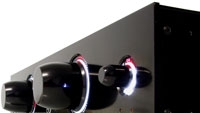Drawmer unveils HQ high-precision studio preamp, converter

Drawmer has unveiled the HQ, a precision high-quality monitor preamp/volume controller and digital-to-analog converter. The HQ is a critical listening device that incorporates an accurate preamp and offers finely balanced volume control over a variety of analog and digital input sources, with extremely low interchannel crosstalk. The HQ also boasts a state-of-the-art converter for clean conversion of digital sources to analog for reference monitoring and accepts up to four analog and five digital sources simultaneously, with individual gain settings, making it ideal for studio operations.
Front-panel rotary controls handle volume adjustment, source selection and destination control, which allows instant switching between two different sets of speakers for quick A/B comparisons or allows the HQ to drive both sets of outputs simultaneously. The HQ’s volume control incorporates Drawmer’s SRVC (Seamless Relay Volume Control) technology, which offers smooth, continuous and quiet operation of a potentiometer combined with the accuracy of a precision relay volume control, keeping the HQ's output channels balanced to within 0.05dB across the entire volume range.
Drawmer’s HQ facilitates fast switching between sources and outputs in multispeaker setups. Analog inputs accept audio on balanced XLRs and unbalanced phono jacks. In addition, separate stereo RIAA-corrected phono inputs are provided, so turntables may be directly connected for restoration work or reference without the need for a separate phono preamp. The HQ also permits the connection of digital sources at up to 192kHz in AES format (via XLRs), TOSlink (via RCA jack) or AES3id (on a BNC connector), and a standard USB B-type connector allows audio to be streamed at lower rates from a laptop.
Each input source, analog or digital, may be given its own input gain settings for optimum level-matching. Audio from mixing desks, turntables, digital audio workstations and DVD, Blu-Ray or CD players may all be united within the HQ and sent to the balanced and unbalanced analog outputs simultaneously. Digital sources at their original sample rate and bit depth can also be routed to a dedicated S/PDIF output.
The professional video industry's #1 source for news, trends and product and tech information. Sign up below.
